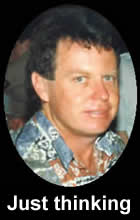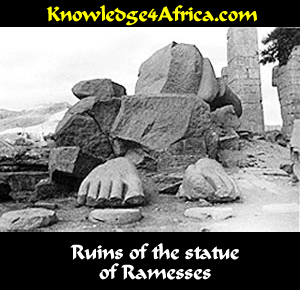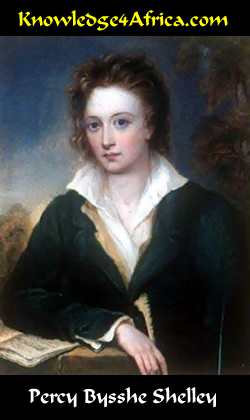|
READ THIS
A traveller has told the poet of a broken statue of a great pharaoh which lies half-buried in the desert
sands of Egypt. It reminded the traveller of how the mighty have fallen, how a great pharaoh -- who
believed himself invincible -- has become but a distant memory whose statue even has fallen into decay
and ruin.
 A NOTE ON THE POET
A NOTE ON THE POET
Percy Bysshe Shelley was born in Sussex in August 1792. He was from an aristocratic family, his father
being a squire and a member of Parliament.
The young Shelley was educated at Eton College and then proceeded to Oxford University but was soon
expelled for publishing an article promoting atheism.
Within a couple of years, the poet eloped with Harriet Westbrook, a working-class teenager. The
marriage, however, was a failure.
He then hitched up with Mary Godwin, daughter of a philosopher and anarchist. She was of a more
literary disposition.
Harriet in the meantime drowned herself which cleared the way for the poet to marry his new love. As
Mary Shelley, she herself would become famous for her novel Frankenstein.

Shelley wrote "Ozymandias" in 1817 when interest in Egyptology was growing. The poet had just
visited the British Museum where he had seen the recently acquired Rosetta Stone, as well as a statue
of Pharaoh Rameses II.
The boast "My name is Ozymandias, King of Kings" comes from Diodorus Siculus's description of
the several monuments to Rameses II. The quote had then appeared in several travel books of the time.
Shelley drowned in 1822 when his small schooner struck a rock and sank. He was only thirty years
of age. His body washed ashore at Viareggio where it was burned on the beach. His ashes were later
buried in Rome.
He is remembered as one of the most successful of the Romantic poets.
Have you looked at the questions
in the right column?
|
TEST YOURSELF!
Read the left column and then answer
the following questions:
VOCABULARY QUESTION:
Give the meaning of the following words:

[Need help?]
The word "antique" usually refers to a very old but valuable object, like a piece of furniture. In this
particular case, however, the "antique land" refers to ancient Egypt.
"Visage" is the face of the pharaoh.
A "pedestal" is defined as the base of a statue, the support upon which the statue rests.
"Colossal" means very, very big. Have a look at the fragments of the statue in the accompanying
picture and you will see just how big the statue must have been.
A "sculptor" is the person who carves in rock or the artist who makes sculptures.
|
"I met a traveller from an antique land
Who said: Two vast and trunkless legs of stone
Stand in the desert."
- Which land is the poet referring to when the poet speaks of "an antique
land"? (1)

[Need help?]
If you got the first question right, or looked up the answer, you will know this one as well: the "antique
land" refers of course to the ancient land of Egypt.
|
- Which Pharaoh does "Ozymandias" represent? (1)

[Need help?]
Apparently Rameses II was sometimes known as Ozymandias. He lived from 1279 to 1213 B.C.E. and
was some 96 years old when he died. He had 200 wives and concubines, with 96 sons and 60 daughters.
|
- What words tell us that the poet had not personally witnessed the scene he is
describing? (2)

[Need help?]
"I met a traveller from an antique land who said . . . " So the whole story is based upon what the
traveller apparently told the poet. Although the "traveller" was probably a travellers' guide-book!
|
- What does the poet mean when he says that the legs of stone were "vast" and
"trunkless"? (2)

[Need help?]
The legs were very, very big but they were detached from the trunk or body of the statue.
|
"Near them, on the sand,
Half sunk, a shattered visage lies, whose frown,
And wrinkled lip, and sneer of cold command,
Tell that its sculptor well those passions read
Which yet survive, stamped on these lifeless things."
- Why should the "shattered visage" be "half sunk"? (2)

[Need help?]
The stone face from the statue of Rameses was lying in the desert sand. As the wind of ages blew, the
sand covered the statue further and further, making it seem as if it was sinking into the sand. Before
modern times, the Sphinx had to be dug out of the sand regularly as it became covered, and looked as
though it was sinking.
|
- What words tell us that the sculptor was accurate in his craftsmanship? (1)

[Need help?]
The poet tells us that the sculptor "well those passions read".
|
- Quote FOUR words or sets of words which tell us that the pharaoh, whose image is captured in stone,
had little affection for his people. (4)

[Need help?]
What about the following words?
- "the hand that mocked them".
Are there any others?
|
|




